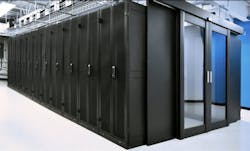A Case for Intelligent Power Distribution Units in a Colocation Setting
In the edition of Voices of the Industry, Ashish Moondra, Senior Product Manager, Power, Electronics & Software, at Chatsworth Products, explores why intelligent power distribution units can be ideal in a colocation setting.
Ashish Moondra, Senior Product Manager, Power, Electronics & Software, Chatsworth Products
The ability to remotely monitor and manage power data from the rack and device level has generated steady and increasing demand for intelligent power distribution units (PDUs). In fact, global revenue in intelligent cabinet PDU is expected to reach about $860 million by 2021, a 7 percent increase at a five-year compound annual growth rate, according to IHS Markit’s most recent report on cabinet power distribution market.
The connection with the growth of the intelligent PDU market and the boom in colocation and multi-tenant data centers is clear. In an enterprise data center setting, organizations often relied on their own onsite staff to make frequent trips into the data center to ensure availability of all cabinet power distribution equipment and their branch circuits. While that was never an optimal solution, it was still an option for budget crunched environments.
In a colocation environment, the end customer must depend on the remote monitoring capabilities of cabinet power distribution units to ensure availability of power to all IT equipment. Recent research by Jeffrey Fidacaro, Senior Analyst with 451 Research, indicates increasing adoption of data center infrastructure management (DCIM) software by colocation operators – either built internally, purchased or a combination of commercial and customization. DCIM can be paired with intelligent PDUs to monitor and track power data, enabling customers to view power usage in real-time, establish alarm thresholds and to generate trending reports.
Within most colocation environments, cabinet power distribution is generally an asset that is managed by the tenants. Intelligent PDUs provide these tenants with several capabilities that ensure high availability, enhance operational efficiencies and provide enhanced monitoring and security to their cabinets. Some managed hosting sites provide these assets as a value-added service option to their tenants.
Most intelligent PDUs generally allow proactive monitoring of the amperage draw, as well as power consumption of all branch circuits and the entire PDU. Ability to set warning and critical thresholds with notification capabilities ensures that the colocation tenants know of any impending power issues before they occur. Failover monitoring to ensure continued power in the event of an outage or maintenance shutdown is enabled by power consumption monitoring and trending of both A & B PDUs within the cabinet. Knowledge of energy consumption associated with an entire PDU enables colocation providers to charge tenants based on their actual energy usage as against overall capacity of the provided rated electrical circuit.
[clickToTweet tweet=”Ashish Moondra – Intelligent PDUs with outlet-level monitoring provide colocation tenants visibility into power consumption of individual IT equipment. #colocation ” quote=”Ashish Moondra – Intelligent PDUs with outlet-level monitoring provide colocation tenants visibility into power consumption of individual IT equipment. #colocation”]
Intelligent PDUs with outlet-level monitoring provide colocation tenants visibility into power consumption of individual IT equipment. Trending of such data over a period helps identification of ghost servers and the power hogs (over or underutilized equipment and capacity). Intelligent PDUs with switching capabilities allow colocation tenants to remotely recycle power to hung up IT equipment. Ability to keep unused outlets within off position also allows proper provisioning of new equipment inside of the cabinets.
Next-Generation Intelligent PDUs
Emerging trends within the space of intelligent PDUs include integrated cabinet-level access control and environmental monitoring. In the past, colocation environments have relied on perimeter or cage-level access control for security purposes. With cases of data breaches on the rise, cabinet-level electronic access control with audit capabilities have taken a new dimension within colocation environments. Integration of this capability into an intelligent PDU nullifies the need for a separate source of power or network to the electronic swinghandles. This makes deployment simpler and cost effective.
All intelligent PDUs in the market support the SNMP protocol that makes it simple to integrate them into overall DCIM applications. With capabilities such as integrated cabinet-level power, environmental monitoring and access control management, intelligent PDUs have become the foundation of any successful DCIM deployment.
With all the functionality and capabilities described above, cost and deployment time are typically perceived as hurdles in the deployment of intelligent PDUs within colocation environments.
Adding each cabinet PDU individually to the network can significantly increase the time and cost of deployment. With IP consolidation capabilities, up to 32 PDUs can be managed through only one or two IP addresses. What that really translates into is just the need for one or two addresses to manage power, environmental monitoring and access control for five to 16 cabinets—a typical small and midsize colocation tenant setup. As shown in the figure below and in this free, online calculator, this significantly reduces the deployment costs and time for intelligent PDUs.
To sum up, intelligent PDUs provide a win-win solution to both colocation tenants and providers alike. Tenants benefit by having a higher level of control on the availability, security and operational efficiencies of their IT deployments. Service providers can better control and maintain service-level agreements (SLAs) with their tenants. Transparency of information allows for better collaboration and relationship between the two parties. The increased value proposition of intelligent PDUs as a holistic cabinet-level management device and technological advancements that simplify deployment should be a no-brainer.
To determine how much you can save by deploying an integrated solution that includes power management, environmental monitoring and EAC, try this IP consolidation saving estimator now.
Ashish Moondra is Senior Product Manager, Power, Electronics & Software at Chatsworth Products.


